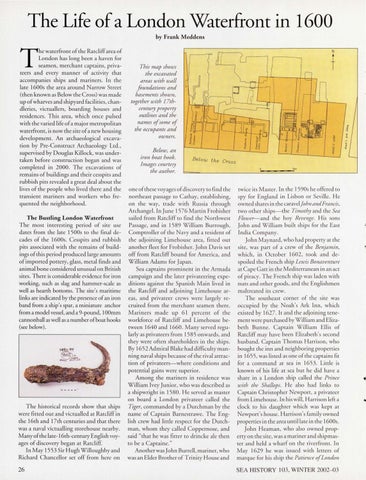The Life of a London Waterfront in 1600 by Frank Meddens
T
he waterfront of the Ratcliff area of London has long been a haven for seamen, merchant captains, privateers and every manner of activiry that accompanies ships and mariners. In the late 1600s the area around Narrow Street (then known as Below the Cross) was made up of wharves and shipyard facilities, chandleries, victuallers, boarding houses and residences. T his area, which once pulsed with the varied life ofa major metropolitan waterfront, is now rhe sireofa new housing development. An archaeological excavation by Pre-Construct Archaeo logy Ltd. , supervised by Douglas Killock, was undertaken before co nstruction began and was completed in 2000. The excavations of remains of buildings and their cesspits and rubbish pits revealed a great deal about the lives of the people who lived there and the transient mariners and workers who frequented the neighborhood.
The Bustling London Waterfront The most interesting period of site use dates from the late 1500s to rhe final decades of the 1600s. Cesspirs and rubbish pits associated with the remains of buildings of this period produced large amo unts of imported pottery, glass, metal finds and animal bone considered unusual on British sires. There is considerable evidence for iron working, such as slag and hammer-scale as well as hearth bortoms. The site's maritime links are indicated by the presence of an iron band from a ship's spar, a miniature anchor from a model vessel, and a 9-pound, 1OOmm cannonball as well as a number of boat hooks (see below).
T he historical records show that ships were fined out and victualled at Ratcliff in the 16th and 17 th centuries and rhanhere was a naval victualling srorehouse nearby. Many of the late-16th-century English voyages of discovery began at Ratcliff. In May 15 53 Sir H ugh Willoughby and Richard Chancellor set off from here on
26
N
t
This map shows the excavated areas with wall foundations and basements shown, together with 1 lthcentury property outlines and the names ofsome of the occupants and owners. Below, an iron boat hook. I mages courtesy the author.
I
n
i
!.._,
l,
Below the Cross 10m
one of rhese voyages of discovery to find the rwice its Master. In the 1590s he offered ro norrheasr passage to Cathay, estab lishing, spy for England in Lisbon or Seville. H e on the way, trade with Russia through owned shares in rhe caraveljohn and Francis, Archangel. In June 1576 Martin Frobisher rwo other ships -the Timothy and the Sea sailed from Ratcliff ro find rhe No rrhwesr Flower- and the hoy Revenge. His so ns Passage, and in 15 89 William Burrough, John and Wi lli am built ships for th e East Comptroller of the Navy and a resid ent of India Company. th e adjo ining Limehouse area, fitted out John Maynard, who had property at the another fleet for Frobisher. John Davis set site, was part of a crew of the Benjamin, off from Ratcliff bound for America, and which, in October 1602, rook and deWilliam Adams for Japan. spoiled the French ship Lewis Bonaventure Sea caprains prominent in the Ar mada at Cape Garr in the Mediterranean in an act campaign and the later privateering expe- of piracy. T he French ship was laden with ditions against the Spanish Main li ved in nuts and other goods, and the Englishmen the Ratcliff and adjoining Limehouse ar- maltreated its crew. eas, and privateer crews were largely reThe southeas t co rn er of th e sire was cruited from the merchant seamen there. occup ied by the Noah's Ark Inn , which Mari ners made up 61 perce nt of th e existed by 1627 . Ir and the adjoining tenewo rkforce of Ratcliff and Limehouse be- ment were purchased by William and Elizarween 1640 and 1660. Many served regu- beth Bunne. Captain W illiam Ellis of larly as privateers from 1585 onwards, and Ratcliff may have been Elizabeth's second they were often shareho lders in the ships. husband. Captain Thomas H arriso n, who By 16 5 2 Admiral Blake had difficul ty man- bought rhe inn and neighboring properties ning naval ships because of the ri val anrac- in 1655, was listed as one of the captains fir rion of privateers-where co nditions and for a command at sea in 1653. Little is known of his life at sea but he did have a potential gains were superior. Among the mariners in residence was share in a London ship called the Prince Will iam Ivey Junior, who was described as with the Sha/lops. H e also had links to a ship wright in 15 80. H e served as master Captain C hristopher Newport, a priva teer on board a London pri vateer called the from Limehouse. In his wi ll , H arrison left a Tiger, commanded by a Dutchman by rhe clock ro his daughter which was kept at name of Captain Barnestrawe. The Eng- Newport's house. Harrison 's family owned lish crew had linle respect for the Dutch- properties in rhe area until late in the 1600s. man, whom they called Coppernose, and John H eaman, who also owned propsaid "that he was fitter ro drin cke ale then erty on the site, was a mariner and ship master and held a wharf on the ri verfront. In to be a Captaine." Another was John Burrell , mariner, who May 1629 he was iss ued with len ers of was an Elder Brother of Trin ity House and marque for his ship the Patience ofLondon
SEA HISTORY 103, WINTER 2002-03
